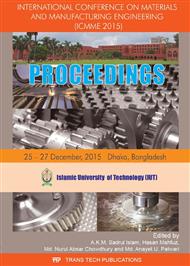p.64
p.70
p.74
p.81
p.87
p.93
p.99
p.105
p.111
Fabrication of CoNiP Thin Films with Improved Magnetic Property for Application in MEMS
Abstract:
This paper reports on fabricated hard magnetic cobalt nickel phosphorous (CoNiP) films with electro-chemically deposition technique on copper substrate in the presence of different urea (0 to 10 g/L) and NaH2PO2 (16 to 21 g/L) concentrations. Thin films were obtained at current density ranges from 5 to 20 mA/cm2 and temperature varies from ambient temperature to 60°C. Magnetic properties namely coercivity, remanent magnetization, saturation magnetization and squareness of the films were studied using Vibrating Sample Magnetometer (VSM). The result showed that for bath containing higher concentration of urea (10 g/L), bright films with higher coercivity were obtained at moderate current density (15 mA/cm2) and at higher temperatures (40-60°C). In contrary, uniform and bright films were produced at ambient temperature in bath containing no urea or lower concentration of urea. Scanning Electron Microscopy (SEM) revealed that porosity and cracking tendency are increased with increasing temperature. CoNiP thin films with improved magnetic properties are thus obtained for plausible applications in high density recording media and MEMS.
Info:
Periodical:
Pages:
87-92
Citation:
Online since:
December 2016
Authors:
Keywords:
Price:
Сopyright:
© 2017 Trans Tech Publications Ltd. All Rights Reserved
Share:
Citation:


